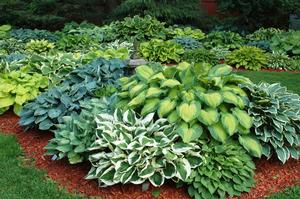Hostas are favored by many gardeners for their exceptional foliage. Growing best in shady spots, they can add color and drama to your garden in places other plants may not grow.
Leaves come in a wide range of shapes, colors, sizes, and textures and may be solid in color or variegated in different combinations of blue, green, white, and yellow. Although they do flower, they are grown mostly for the decorative foliage and the plants remain attractive from spring till frost.
The subtle colors, the tall flower-stalks and the broad, coarse leaves fill a niche in the garden that few other plants can achieve. The large leaves provide excellent coverage for dying bulb foliage. Use them for a ground cover, for edging, or as an accent plant in a shady garden. The bell shaped flowers are also known to attract hummingbirds and butterflies. Knowing how to plant hostas so that they thrive will help you enhance your garden.
Hostas prefer well-drained soil with a slightly acidic pH. Hostas are light to moderate feeders. It is best to incorporate a slow release fertilizer in the soil prior to transplanting. If topdressing is desired, apply to the top of the soil after planting. Some varieties are sun tolerant, but all prefer at least 30% shade for best growth and quality.
Dividing Hostas
- Division should be done when no shoots are growing from the center of the mature clump and this bare area detracts from the appearance of the plant. Division of the clump will improve the plant’s appearance. Lift the entire hosta clump and wash the soil from the roots if possible. This makes it easier to see where to cut to divide the clump. Cut with a sharp knife to make the divisions.
- Spring is the easiest time to divide plants because new shoots are only a few inches high and the leaves have not expanded. Be careful not to overdivide hostas in spring; divide only the fast growing hostas then. Do not divide the sieboldianas or the tokudamas in spring. New roots will not grow until the foliage has fully expanded and hardened off. During this period, the leaves may desiccate quickly on warm days, since the roots have been reduced in size or were injured during division. A hot day may cause injury such as leaf burn, but this is probably not permanent damage.
- Though spring division is easiest, summer division is preferred and can be done in August, at least 30 days before the first fall frost date. Warm soil and higher humidity at this time promotes better root growth, and plants may put on a little growth spurt at this time.
- Keep newly divided plants well watered for the first two weeks, especially if there is a period of drought. Some of the larger leaves on a division may be cut back to reduce water loss. Frequent division of a clump will restrict plant and leaf size, and keep it from developing to its desirable mature features.


